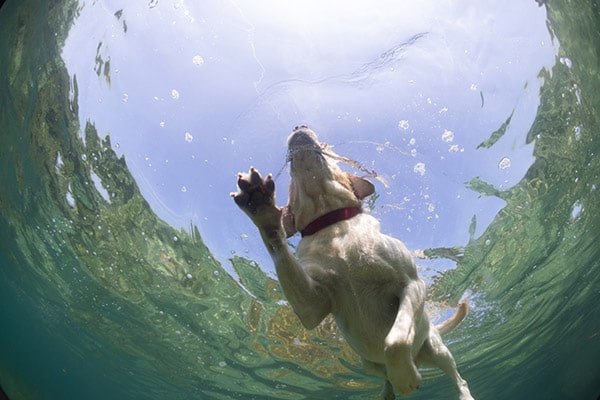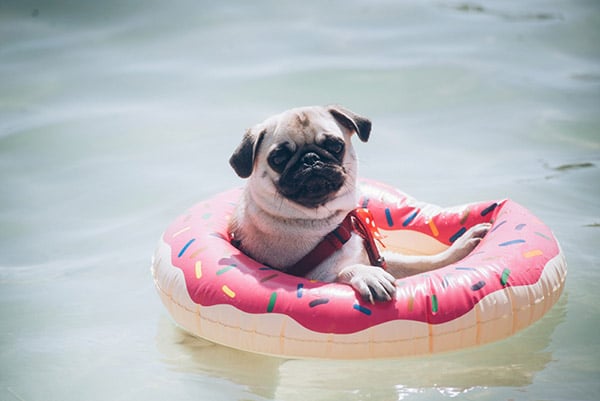Dogs are no strangers to water, with numerous loving the occasional dip in the pool to cool off during the summer months.
While most canines have natural swimming abilities, some are not well equipped to stay in the water for long, raising concerns about their safety.
Did you know that yes, dogs can hold their breath?
The following guide outlines some tips that pet owners can use to increase the safety of their dogs while around water.
Can Dogs Swim Underwater?

The short answer to this is yes.
However, not all dogs can swim well underwater, with some likely to drown if left underwater for long.
While swimming will be an instinct like barking or walking, it will require practice to perfect it.
Most dogs start by swimming with their head above the water, after which they can swim underwater to retrieve objects.
A few dog breeds that are naturally good swimmers include the Irish Setters, Spaniels, Golden Retrievers, Newfoundland, and English Setters.
Due to their strong limbs, these breeds are likely to be better swimmers than their other counterparts.
Smaller breeds can still enjoy the water but will often need to be taught how to swim.
These include Dachshunds, Bulldogs, and Pugs.
Their short legs make it difficult to stay afloat for a long time, resulting in quick burn-up.
If you have Chihuahuas or Maltese breeds, they will also likely need some help as they could get afraid of the water.
They are, however, good swimmers once they overcome their fear.
How Long Can Dogs Hold Their Breath Underwater?
Dogs can hold their breath underwater for about 5 to 8 seconds.
This will, however, depend on various factors, such as the breed, the size, and age.
If, for instance, you have Pugs or Basset Hounds, their lung capacity will often not be adequate to help them stay underwater for long.

These generally have low amounts of oxygen in their body tissues, limiting the time they can stay underwater.
These breeds are also prone to respiratory problems that make it even more challenging to hold their breath underwater for long durations.
If your dog also has a short nose, it will likely have difficulty while underwater.
Such breeds tend to use their noses more than others, lowering their breathing capacity while in the water.
How Deep Can Dogs Dive Underwater?
Dogs can dive as much as 15 feet, with some breeds, such as the Retriever, likely to exceed this depth.
As previously mentioned, this will depend on lung capacity and the type of breed you have.
Dogs with large lung capacities can dive further underwater, increasing the duration that they can hold their breath.
Unfortunately, this will often not last into old age, with the size of lungs decreasing as they age.
The only exception is the Newfoundland breed, which retains its lung size even in old age.
Can You Teach a Dog To Hold Its Breath?
Teaching a dog to hold its breath underwater will be an impossible task, with the mammalian diving response only kicking in as an automatic reflex when your dog dives underwater.
This response is called bradycardia, which instantly slows down your dog’s heart rate.
This function also works closely with the peripheral vasoconstriction response, narrowing your dog’s blood vessels and allowing it to reserve oxygen use for crucial organs like the heart and brain.
When these responses are triggered, your dog can increase the time spent underwater without drowning.
Training them how to swim underwater will, however, be possible with a few tricks for this being:

Using Exciting Toys
Dogs are often attracted to exciting toys, with colorful and sinking toys being an excellent way to start their swimming lessons.
Allow your dog to get accustomed to its chosen toy by playing with it around the garden before getting to your pool, which helps create a positive interaction.
Start Small
Once your dog is used to its toy, play around the pool by initiating simple exercises like a tug to allow him to get used to the water.
Start in the shallow end before getting into the deep end.
Throw the toy into the pool for a game of catch, after which you can reward your dog with a treat once they retrieve it.
When starting, remember to use a vest, especially for dogs that show signs of fear or are unfamiliar with the water.
The life vest should be well fitted as this will be crucial in helping them stay afloat.
Brightly colored vests will be the ideal for this initial step, allowing you to keep a close eye on your pet.
Have an Exit Plan
Once you begin your water exercises, ensure that you have an exit plan for your pet.
Your dog needs to know how to get out of the pool whether you are around or not.
You can direct your dog to the steps in your pool to ensure they know how to get out if they get tired.
If there are no steps, make it a point to be close to the pool during your swimming sessions.
Dive Into the Water
The next step will be getting into the water and encouraging your dog to dive further into the pool.
Hold the toy further under the pool and invite him to follow your lead.
You can do this by waving the toy around and talking reassuringly to let your pet dive further.
Diving further allows your dog to engage his hearing abilities underwater, making it an overall calming experience.
Introduce Play Time Underwater
After your dog gets more comfortable swimming underwater, try dragging the toy below the water’s surface.
This will increase the amount of time they can hold their breath underwater.
Do this for a few seconds, after which you should let him have the toy.
Ensure that you hold the toy throughout this period to ensure that they can see it.
Follow this with a treat or words of affection to encourage them.
Schedule Breaks
Breaks will be an essential part of your training sessions, with burnout likely to result in accidents.
To keep your dog safe during your swimming sessions, introduce breaks every few minutes.
This will especially come in handy during your initial sessions, helping your canine friend enjoy their time out in the water.
Keep treats close by and carry other toys for some playtime around the house.
Dive Deeper
Based on how well your dog performs the above exercises, you can now proceed to dive deeper into your pool.
For consistency, use the same toy and take it deeper into the water as time passes.
Repeat this over the next few days to allow your dog to get more confident underwater.
Ensure that you also stay close by their side, which helps reassure them that they are safe.
Lastly, make it a point to use treats and affection during your sessions to encourage them to dive deeper on their own.
